Art Restoration Project: Dome of the Rhode Island State House
September – October 2016
by Charles C. Clear III and Richard Pawlak
The Rhode Island State House is easily the grandest, most majestic building in Providence, Rhode Island. It boasts the fourth largest unsupported marble dome in the world, right behind Saint Peter’s Basilica in Rome, the Minnesota State Capitol, and the Taj Mahal. With its large dome and white exterior, the State House makes a bold impression on the Providence skyline:
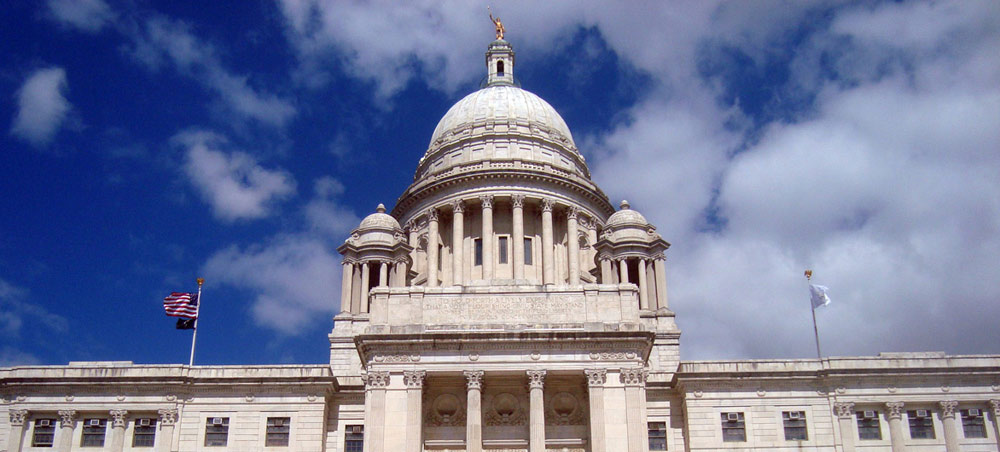
The State House was designed by the renowned New York architectural firm of McKim, Mead, and White, and built between 1896 and 1904. The building is 333 feet in length, 189 feet in height, and contains an astounding 327,000 cubic feet of white Georgia marble! If its distinctive shape and neoclassical style look familiar, its because it was modeled after the US Capitol Building in Washington. The resemblance is strong enough, in fact, that in 1997 Steven Spielberg used the Rhode Island State House as a stand-in for the Capitol when he made his movie ‘Amistad’.
Inside the State House, there’s a large historic mural that fills the entire dome. You can see it there in the center top:
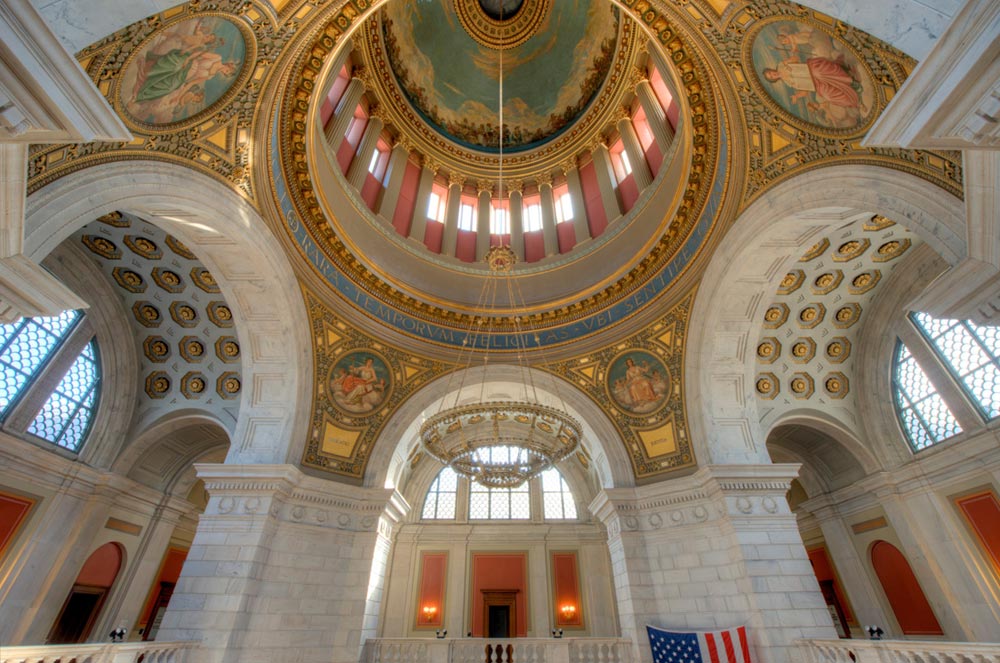
Titled “The Four Freedoms”, the mural depicts Rhode Island’s early history: Roger Williams receiving a land grant from the Narragansett Indian Chief Canonicus; plus religious tolerance, the beginning of industry, and the origins of construction. Completed in 1947, the historic mural was designed by artist James Allen King and painted by George DeFelice, Victor Zucchi, and Robert J. Haun.
In recent years the mural had suffered substantial water damage from above, which caused the paint to peel in a number of areas. Portions of the sky and clouds, as well as three figures in the mural, were all but gone. The gilded molding that circles the top of the dome was also in need of repair.
Richard Pawlak, of Mashpee, Massachusetts, and I are the Artists who were contracted to repair the damage and perform the art restoration in the Dome. The general contractor on this project was Martone Service Company Inc., of Narragansett, Rhode Island. They erected the scaffolding in the rotunda over the course of six weeks.
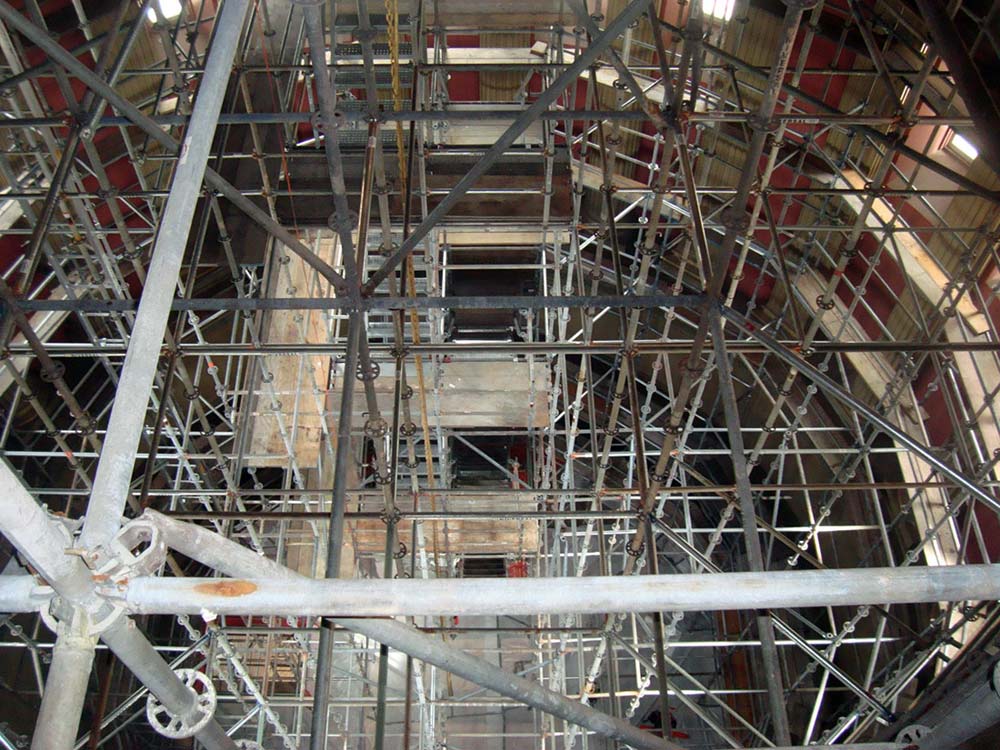
The scaffolding inside the Rhode Island State House fills the entire rotunda, and stretches from the ground floor 164 feet to the top of the dome. To get to the mural, you have to climb, and your journey starts at a makeshift entrance over the third floor balcony. From there you have four flights of rickety scaffolding stairs. They’re very narrow, the handrails move, and there’s an opening between the flights that requires a step of faith. At the top of those four flights there are two short platforms separated by a vertical ladder. This leads to a temporary sub-floor that was erected to catch falling items – like tools, or paint, or people. I call this area “base camp” because the real climb is yet to come – at least ten more stories of scaffolding stairs, and another much longer vertical ladder to get to the very top.
At left is a picture of the scaffolding inside the rotunda, and the floor that you see at the bottom is the temporary sub-floor that I call “base camp”. In this area there is a quote from the first century Roman historian Tacitus. It’s carved around the interior of the dome in large gold letters, and it reads “RARA TEMPORUM FELICITAS UBI SENTIRE QUAE VELIS ET QUAE SENTIAS DICERE LICET”, which means “Rare felicity of the times when it is permitted to think as you like and say what you think.”
All in all, it’s 127 steps to get to the bottom of the mural, and another 30 more to get to the very top. That may not seem like much, but when you factor in the weight of the paint, the supplies, and the 9 bottles of water that you have to carry up every day, it’s a lot of work. And it’s a journey that you will have to make more than once per day. Just think: If you have to go down for any reason – like to use the bathroom – you will have to climb 300 steps!
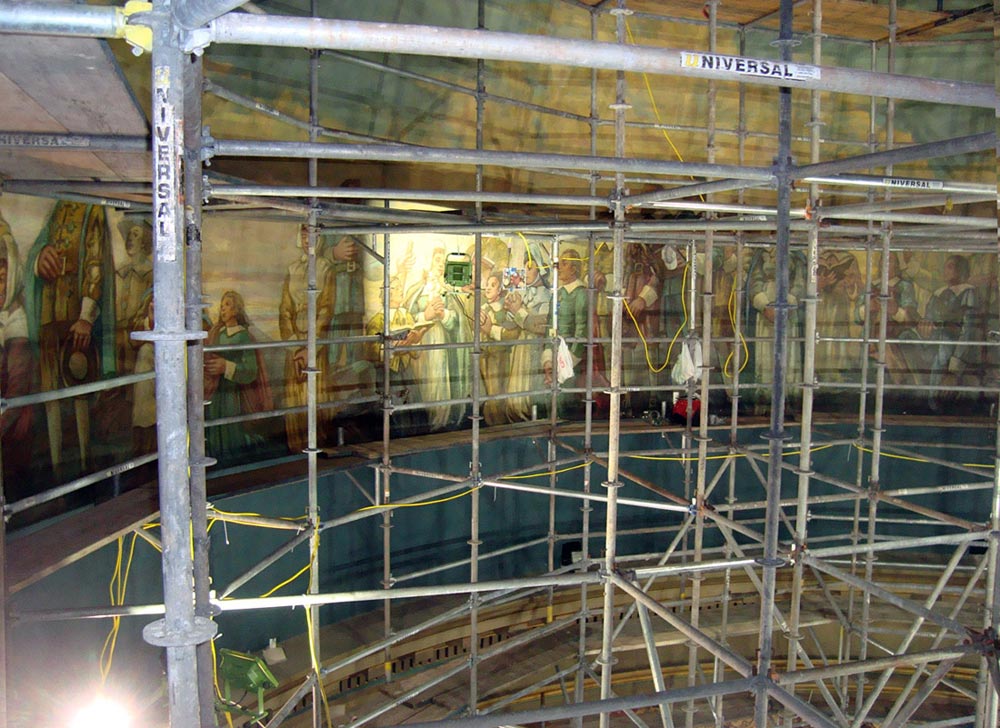
Once you’re inside the dome, to get to the mural you have to walk on catwalks consisting of two wooden planks that border the perimeter of the scaffolding. You can see them in the picture above. On one side the scaffolding has a handrail, but on the other side – the mural side – it’s a ten foot drop to a small ledge. If you should fall and that ledge doesn’t stop you, then it’s a straight shot down to base camp – and that would not be good!
Fortunately heights are not a problem for me, and working off of planks is all second nature. The one thing about this job that did surprise me, though, is that the scaffolding swayed. And I don’t mean a portion of the scaffolding – I mean the entire structure! You wouldn’t think it possible with so much steel and so many connections, but it does – it sways! And it’s not because other people are moving around on it either. I spent a couple of days in the dome where I was working entirely on my own, with no one else in there, and even by myself standing still on a plank painting, the scaffolding swayed. Weird!
For me, the first order of business on this art restoration project was to restore the three figures that were nearly wiped out from the water damage. Here I am priming the surface of the mural after removing what remained of the loose and peeling paint. In this picture you can see the parts of the original work that remained intact.
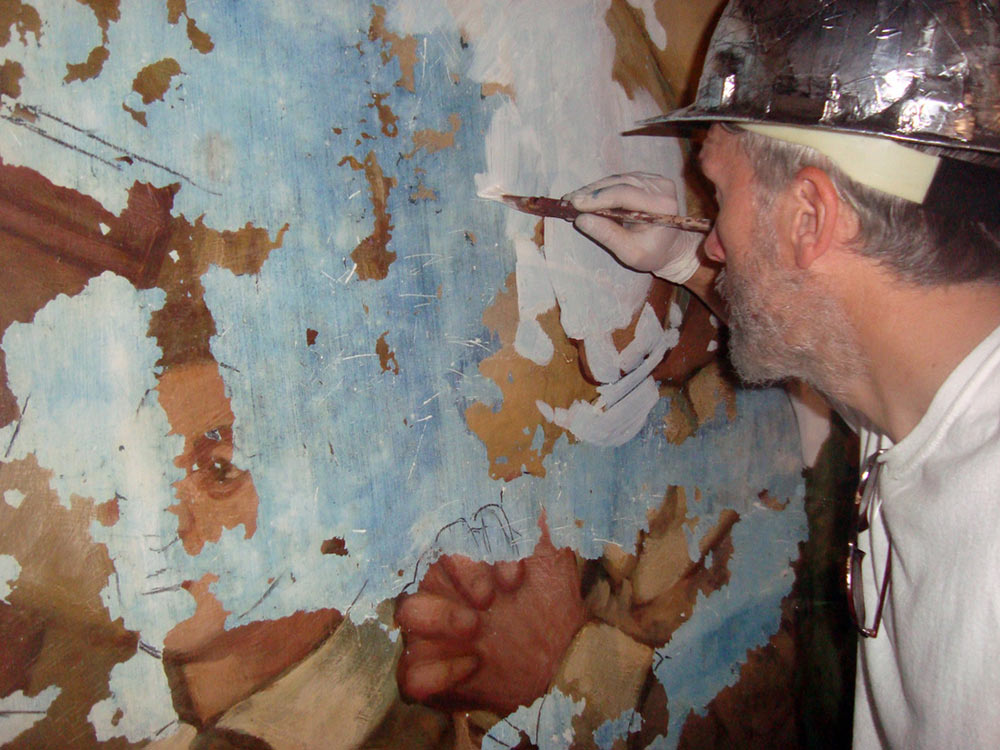
This woman in the mural suffered substantial water damage. The paint on her face and torso was either peeling or had fallen off completely. After scraping, sanding, and priming, I started painting her back to life. In order to match as closely as possible the original work, I used several photographs as a reference to repaint this woman – some new, some old. The black and white photograph of the woman is from a picture that was taken by the Providence Journal upon completion of the mural in 1947:
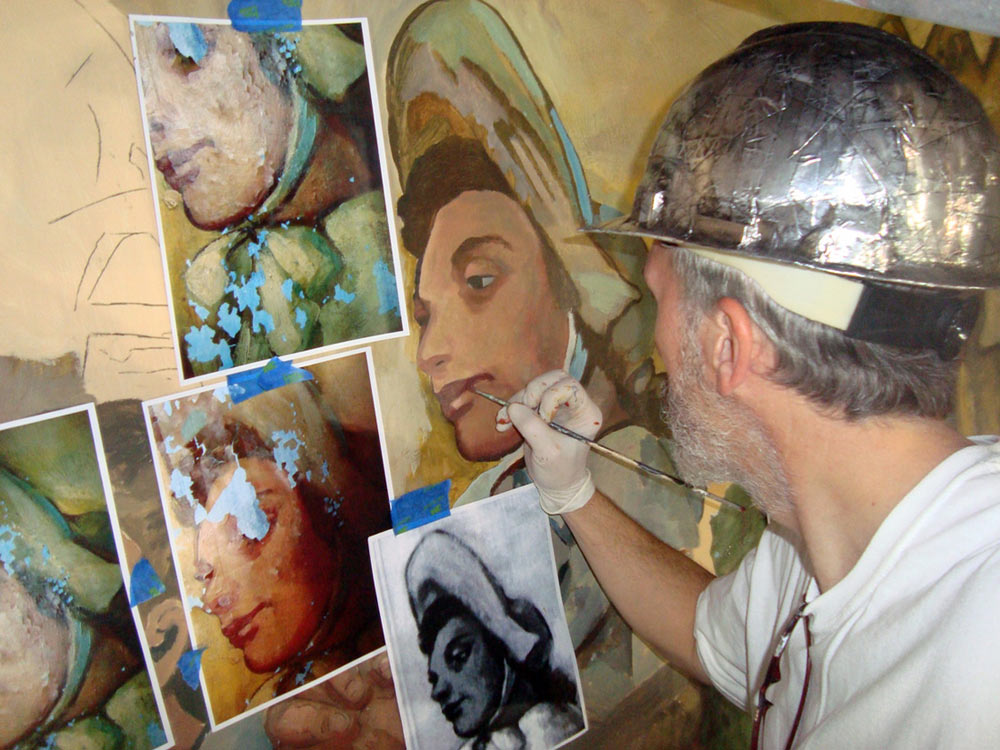
And my hardhat – my hardhat was transformed into a work of art by the famous Artist Bonnie Lee Turner!
I didn’t often take a break while working on this art restoration project in the dome, but when I did, I liked to sit with my feet dangling over the scaffolding. It made me feel very free, like I was floating….and the view was spectacular! It was like being inside a giant machine….
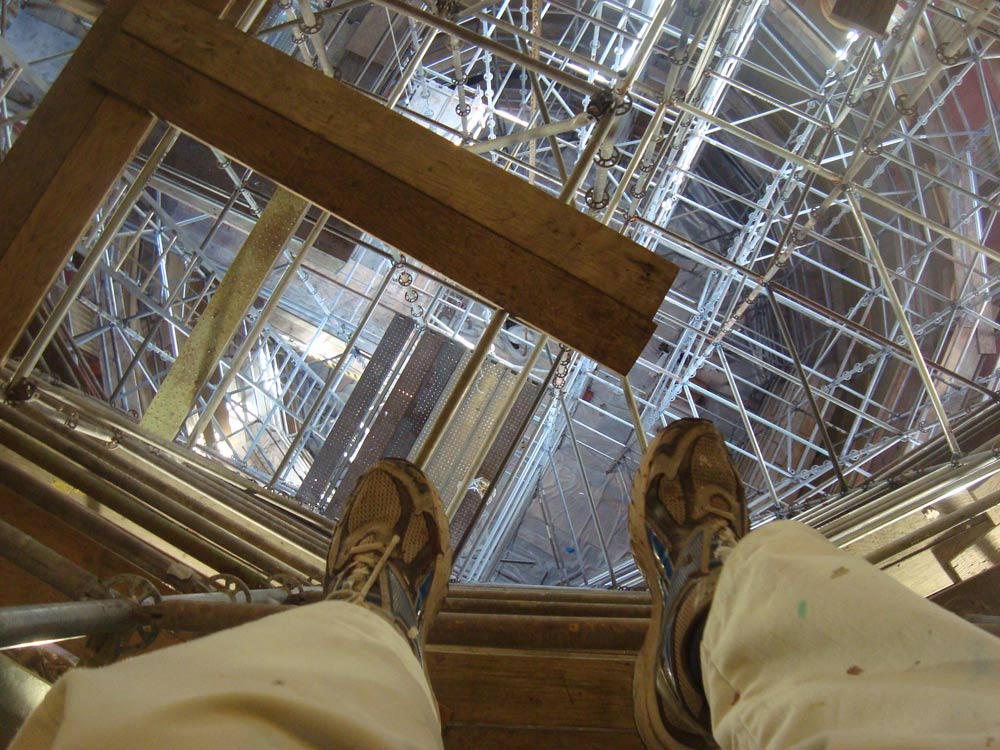
I took this picture after the scaffolding was removed from in front of the three figures that I had restored. They’re the man, woman, and child kneeling in the center. My mission was to paint them in the same style as the original artist, so that no one could tell the difference between them and the other figures in the mural.

After repainting the figures back into the mural, Richard Pawlak and I repainted the water damaged areas of the sky. We matched the muted greenish-blue sky and brownish-orange clouds, then topped it with a glaze to mimic the original work. After that we went up to the very top of the dome, and restored the gold that surrounds the oculus. You can see a portion of that area in the picture below. There were also gold medallions that needed work, along with the green backing panels, and the dark brown molding.
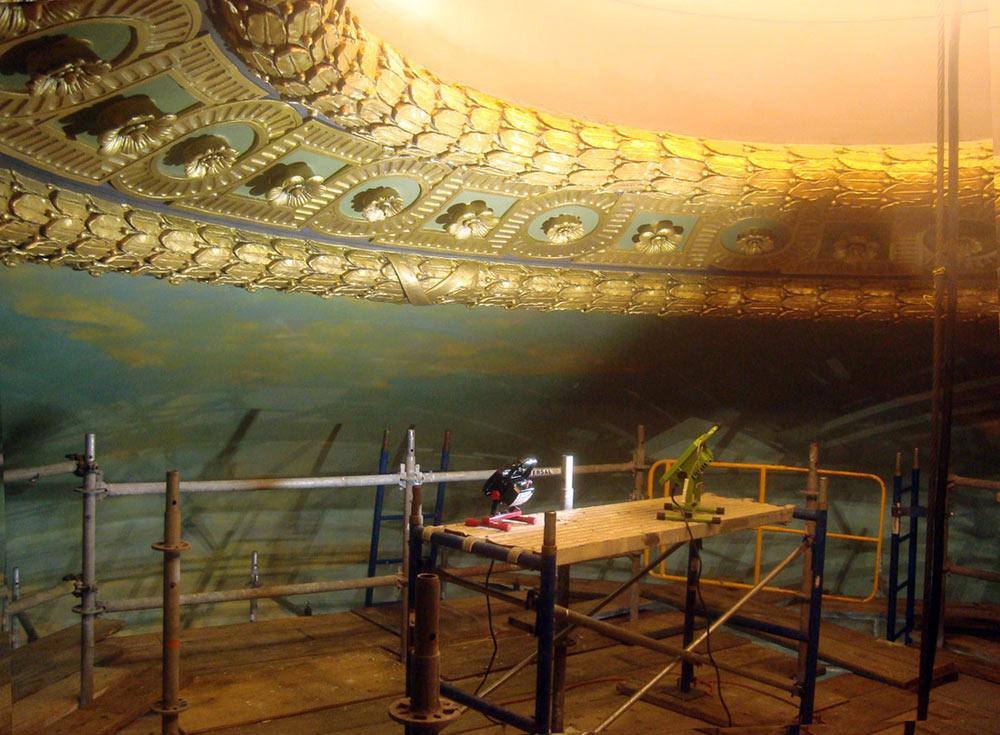
In spite of the climb, the planks, the high humidity, and the swaying scaffolding, Richard Pawlak and I accomplished our restoration mission: We removed the peeling paint, prepared the damaged areas, then painted the missing pieces back into this historic mural. We were able to match exactly the original artist’s muted color palette and staccato brush work, and for the most part, the mural has now been restored to its former glory. It was quite an adventure!
The last thing an Artist does is to add their signature to a work of art. This is me signing my name after Richard signed his. Our signatures are on a structural landing about half way up in the Dome. I think our signatures make the building more valuable….
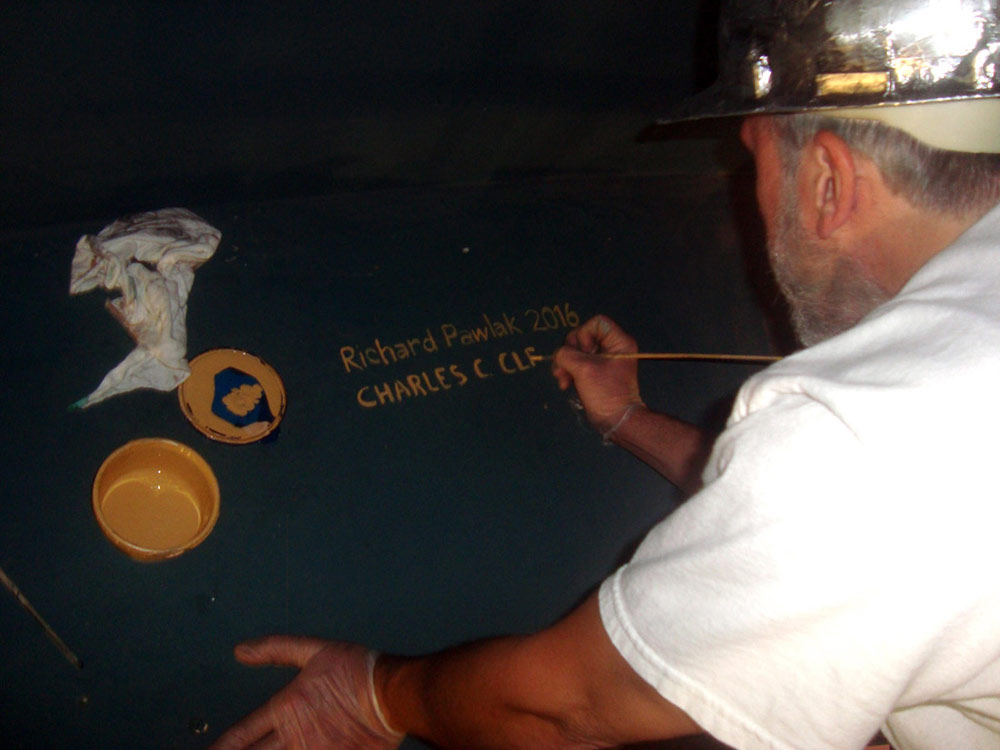
And this is the last picture that I took of the Dome before I left the State House for the last time. The figures that I repainted are there in the bottom, surrounded by the muted blue sky and bronze clouds that we touched up, along with the big gold oculus in the center. I should point out that in addition to the art restoration of the mural and related areas at the top, I also painted the red around all of the windows in the Dome. The windows may look small here but they’re actually very tall – about 12′ feet in height!
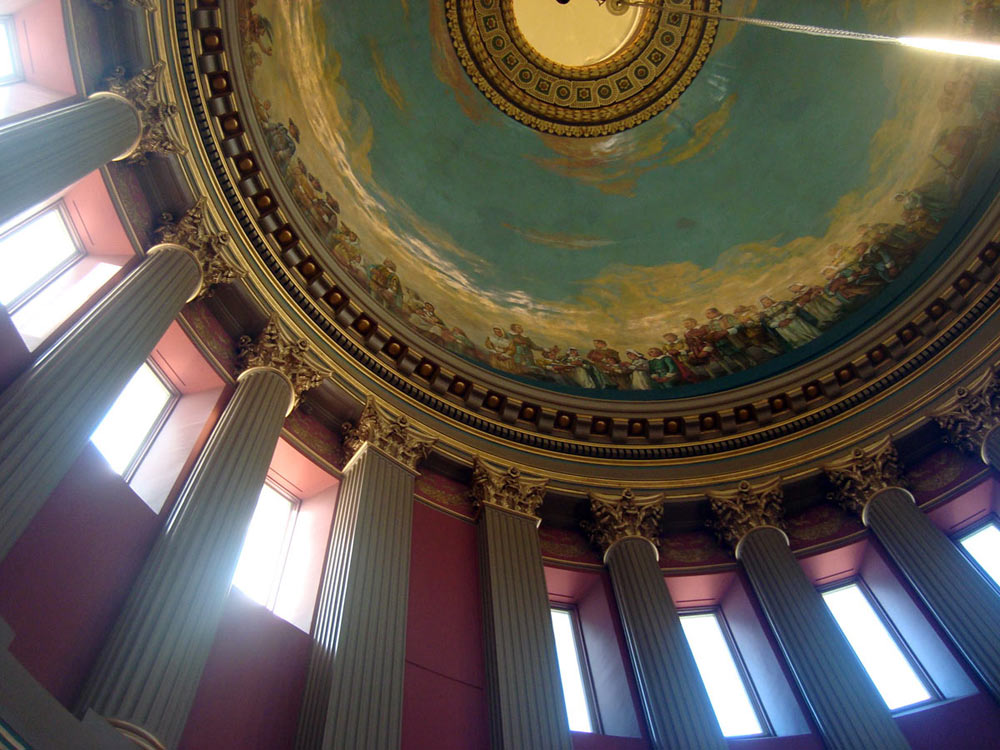
Art Restoration projects are rare, but they do come up from time to time. Over the years I’ve worked on a number of art restoration and/or conservation projects here in Rhode Island. At the Stadium Theater in Woonsocket in 2019, I had to perform extensive repair on two 35′ water damaged walls prior to restoring the faux finish in the Grand Hall; At St. Peter’s By The Sea Episcopal Church in Narragansett, I was part of a crew that restored the decorative painting around the Altar; Other projects included Fairholme Mansion in Newport, St. Agatha’s Church in Woonsocket, the Scandinavian Home in Cranston, St. Elias Church in Woonsocket, etc. etc.
While every project is unique and rewarding in its own right, the most fun project to date was the art restoration of the mural inside the Dome of the Rhode Island State House.
Charles C. Clear III
cc@theartoflife.com